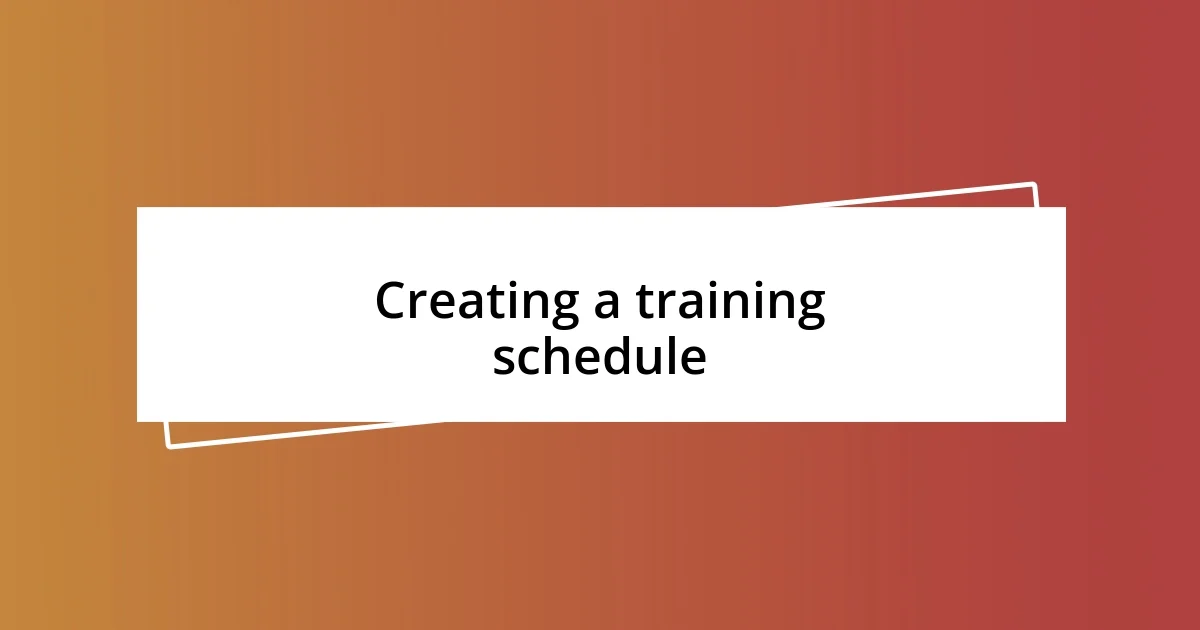Key takeaways:
- Setting clear personal and emotional goals enhances motivation and enjoyment during ultra-endurance training.
- Understanding and properly managing nutritional needs, including hydration and meal timing, is crucial for optimal performance.
- Regularly reviewing and adjusting training plans and mental strategies maintains enthusiasm and readiness for race day.

Setting clear personal goals
Setting clear personal goals is fundamental in my preparation for ultra-endurance events. Recently, I set a goal not just to finish my last race, but to do so while enjoying the journey. I remember crossing the finish line with a smile, not just relieved, but proud—how many people can say they truly loved the experience?
When I reflect on my experiences, I find that setting specific, measurable goals helps keep me motivated. For instance, I’ve aimed to improve my pace by a certain percentage or to conquer a particular challenging section of the course. Have you ever focused on those small victories? They not only build momentum but also bolster confidence as you inch closer to that bigger finish line.
It’s essential to consider emotional milestones too. I once set a goal to connect with fellow competitors along the route rather than just focusing on my time. That camaraderie transformed the race into a shared adventure, highlighting the joy of community. So, what’s your emotional goal? Understanding your underlying motivations can make the rigorous training feel less like a chore and more like a purposeful journey.

Understanding nutritional needs
Understanding nutritional needs is crucial when preparing for ultra-endurance events. I’ve discovered that fueling my body properly directly impacts my performance and recovery. In my early races, I often overlooked how important it was to maintain a consistent intake of carbohydrates, fats, and proteins, which led to energy dips that felt like hitting a wall. Now, I focus on crafting a nutrition plan that aligns with my training intensity and duration.
Here are some key components I consider for my nutritional needs:
– Carbohydrates: Fuel for sustained energy, especially during long runs. I aim for complex carbs like whole grains and fruits.
– Proteins: Essential for recovery and muscle repair—lean meats, legumes, and dairy are my go-to.
– Fats: Important for long-lasting energy; I opt for healthy fats from nuts and avocados.
– Hydration: Staying well-hydrated is vital. I pay attention to electrolyte balance, especially on longer training days.
– Timing: I prioritize meal timing, making sure to eat a well-balanced meal before and after workouts for optimal performance recovery.
I once made the mistake of neglecting my hydration strategy during a grueling training session, which resulted in cramps that derailed my progress. That experience taught me how critical it is to listen to my body and respond accordingly, not only during the race but in my training as well.

Creating a training schedule
Creating a training schedule is like mapping out a journey for an ultra-endurance event. I remember the first time I tackled the task; I was overwhelmed thinking of everything I needed to fit in. But I soon realized that breaking it down into manageable chunks made it less daunting. I typically start with a base of weekly mileage that gradually builds over the months, keeping in mind crucial periods for tapering before the event.
One critical aspect I’ve learned is to incorporate variety into my training. Each week, I mix in long runs, intervals, and recovery days. For example, I’ll dedicate Saturdays to long runs that mimic race conditions, while Wednesdays might be reserved for speed work on a track. It’s fascinating to see how my body responds differently to each type of training. Have you considered how variations will affect your performance? Including cross-training activities like cycling or swimming can not only prevent monotony but also enhance overall fitness.
Ultimately, I keep a flexible mindset. Life can throw curveballs—work commitments, unexpected weather changes, or even illness. I once had to adjust my entire week’s training due to a last-minute work obligation. Instead of being discouraged, I saw the opportunity to focus that week on strength training, which actually benefited me in the long run. Keeping my training schedule adaptable has helped me stay fresh and motivated while ensuring I’m prepared for race day.
| Training Day | Focus |
|---|---|
| Monday | Recovery run (easy pace) |
| Tuesday | Strength training (core and legs) |
| Wednesday | Speed work (intervals) |
| Thursday | Cross-training (cycling or swimming) |
| Friday | Rest day |
| Saturday | Long run (race simulation) |
| Sunday | Active recovery (yoga or light stretching) |

Incorporating recovery techniques
Incorporating recovery techniques into my training routine has been a game-changer. I can’t stress enough the importance of rest days and active recovery. Early on, I used to push through fatigue, thinking it would make me stronger, but I found myself facing burnout instead. Now, I prioritize restorative practices like yoga and foam rolling to help alleviate muscle soreness and improve flexibility. Have you ever felt that deep, refreshing sigh after a light stretching session? It makes a world of difference.
One recovery technique that I’ve recently embraced is the use of compression garments. I remember post-race how swollen my legs would get, and slipping into compression socks has truly changed my post-race routine. The gentle squeeze helps reduce swelling and promotes blood flow. I always feel rejuvenated after wearing them for a few hours. It’s like giving my legs a gentle hug after they’ve worked hard!
Sleep is another crucial element I consciously weave into my recovery strategy. Reflecting on my training, I used to dismiss the idea of adequate sleep, thinking I would catch up later. But sleepless nights left me drained and impacted my performance. I now prioritize a solid nightly routine, focusing on winding down and ensuring I get quality rest. It’s amazing how a few extra hours of sleep can influence my energy levels during long runs. How do you ensure you get enough shut-eye during your training period?

Selecting the right gear
Selecting the right gear is foundational for any ultra-endurance event. I remember standing in the outdoors gear shop, overwhelmed by the array of options. My first purchase was a pair of trail running shoes that were too rigid, which left my feet sore on long runs. Since then, I’ve learned to prioritize comfort and fit over brand names—finding the right pair that hugs my foot without restriction has made all the difference in my training. Have you ever experienced foot fatigue just from wearing the wrong shoes? I’m sure many can relate.
When it comes to apparel, I always look for moisture-wicking fabrics. I recall a race where I wore a cotton shirt; halfway through, I was soaked and felt heavier than ever! Switching to synthetic fabrics has not only improved my comfort but also my focus on the trail. It’s fascinating how something as simple as choosing the right shirt can impact my performance. I typically opt for layers as temperatures can swing dramatically. How do you cope with changing weather during your runs? I’ve found that packing extra layers in my drop bags is a lifesaver.
Hydration systems are another essential component. Early in my ultra-running journey, I made the rookie mistake of relying solely on aid stations. I remember feeling dehydration creeping up on me during a mid-race slog. Now, I use a hydration pack that allows me to sip on water as needed, keeping my energy levels consistent. The freedom of carrying my own supplies empowers me, allowing me to maintain focus. It’s an adjustment in mindset—ensuring you are self-sufficient can enhance not just performance but confidence across those grueling miles. Isn’t it reassuring to know you’re fully prepared?

Mental preparation strategies
Mental preparation is just as important as physical training for ultra-endurance events. One strategy I’ve embraced is visualization. I often take moments to imagine crossing the finish line, feeling that electrifying surge of accomplishment. It’s like a mental rehearsal that makes the daunting miles ahead seem more approachable. Have you ever tried picturing a successful outcome during tough training days? It shifts your mindset in a remarkable way.
Another technique I’ve found invaluable is creating a mantra. When fatigue kicks in during a race, repeating my chosen phrase helps center me and combat negative thoughts. In my early races, I struggled with overwhelming doubts that would creep in when the going got tough. Now, having a positive affirmation—like “stronger with every step”—allows me to push through those moments of weakness. Isn’t it surprising how simple words can invigorate your spirit and keep you moving forward?
Additionally, I prioritize regular mental check-ins throughout my training. Whenever I hit a wall, I pause and assess my mindset, considering factors like stress and emotional well-being. I took this approach after feeling mentally drained during a particularly long training block. By recognizing my mental fatigue, I learned to incorporate mindfulness techniques, such as meditation and breathing exercises, to regain focus. How do you tend to your mental state while preparing for an ultra? I’ve discovered that nurturing my mind is just as crucial as the miles I log.

Reviewing and adjusting plans
Reviewing and adjusting plans is a critical step in my preparation for ultra-endurance events. I start by reflecting on my training log, analyzing what worked well and what didn’t. After one particularly grueling training cycle, I found myself drained and unmotivated; the scheduled long runs became a chore instead of a thrill. That prompted a deep dive into my plan, leading me to realize I needed to incorporate more rest days and variety in my routes. Have you ever felt like you were on autopilot during your training? Shaking things up can rekindle your enthusiasm.
Adapting my nutrition plan has also been part of this review process. I recall a race where I crashed midway due to underestimating my fueling needs. Since then, I’ve become diligent about experimenting with various gels and snacks during long runs to see how my body responds. This trial-and-error approach has led me to discover what truly works, making my nutritional strategy feel less like guesswork and more like a refined science. Isn’t it empowering to find that perfect fuel that keeps you going?
As race day approaches, I typically do a final evaluation of my mental and physical readiness. A few weeks before one of my biggest races, I began to feel uncertainty creeping in. I chose to revisit my goals and, remarkably, adjusting them to be more in line with my current training brought an unexpected wave of clarity. It was a reminder that flexibility is key—not just in the body, but in our aspirations. Have you ever had to recalibrate your expectations? It’s a humbling yet necessary process that can truly enhance your performance.














